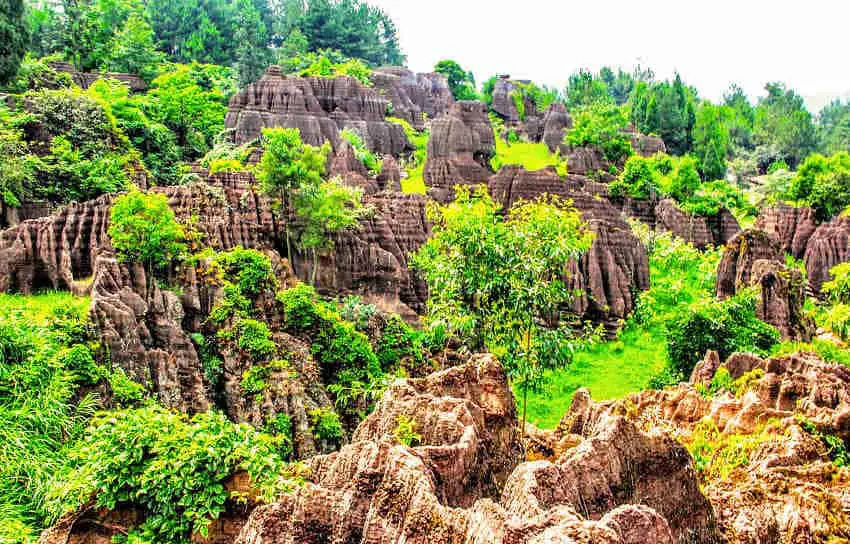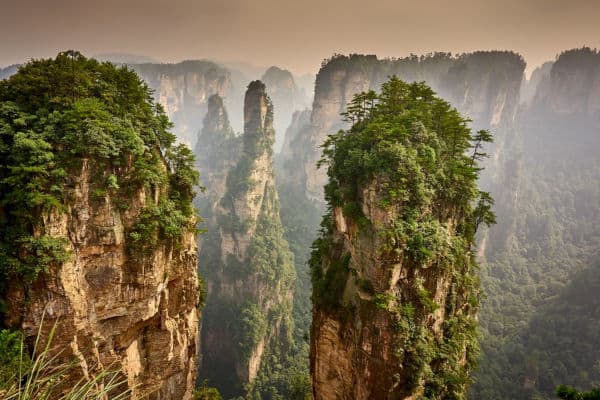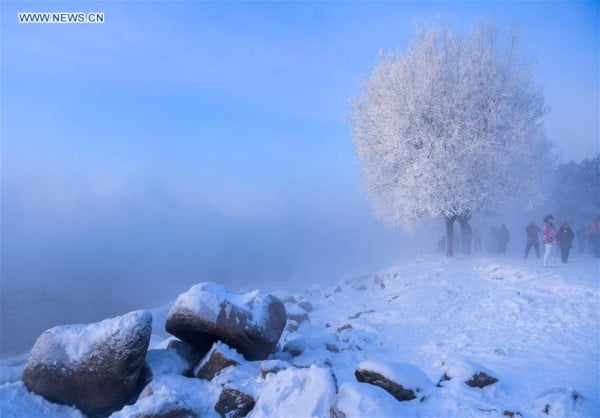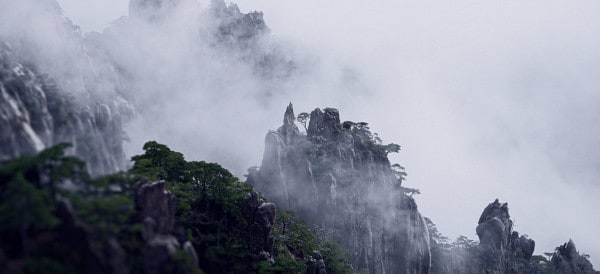
With the massive landmass of China, it would only make sense that there is no shortage of amazing natural places from vast deserts, to mountains standing into the sky to mesmerizing landforms. In fact, if you can only choose just one Asian country to explore natural miracles, China is your best bet.
With the abundance of beautiful nature in China, making a list of just some of them is very difficult. However, below, we will discuss the top five natural beauty in China which, after much consideration, are the best in representing China’s richness of natural wonders.
Let’s start with the first one.
1. Zhangjiajie National Forest Park in Hunan
- Where is it: Wulingyuan District, Zhangjiajie City, Hunan Province
- Highlights: Massive geologic formation, parks, canyons
- Best to visit: Spring and Autumn (March-May, September-November)
This is probably the most famous natural place in China due to the movie James Cameron’s Avatar.

Zhangjiajie is the first National Forest Park in China, and since 2004, is listed as UNESCO’s global geopark. The massive park covers a total area of 1,840 hectares and is formed by complex and rather strange geological structures.
In total, there are more than 3,000 extremely tall peaks you can see in Zhangjiajie. Besides Avatar, Zhangjiajie is also where many Chinese movies and TV productions were filmed.
The vertical cliffs, however, aren’t the only highlight of Zhangjiajie: there’s the famous Tianzi Mountain, Gold Whip Stream, and Yuanjiajie.
What To See in Zhangjiajie:
- Yuanjiajie Scenic Area
Yuanjiajie (�家�, literally translated to “Yuan Family Territory”), is the area with the famous Avatar Hallelujah Mountain, and so it is the most popular area in Zhangjiajie.
We’d recommend you to get up to Yuanjiajie via the Hundred Dragon (Bailong) elevator, but the queue might be very long so we’d recommend arriving before 7 A.M to avoid the peak hours.
- Tianzi Mountain
Tianzishan (天子山), literally translated to The Mountain of Heaven’s Son while Heaven’s Son can also be translated as “Emperor”.
So, you can see how the Chinese took pride in this Mountain. You can reach this area by taking a 30-minute cable car ride.
- Yellow Stone Village
黄石寨 (HuangshiZhai) or Yellow Stone Village is another essential tourist site where you can see the famous Five-Fingers Peak, but also other attractions like the Needle Peak, Imperial Edict, and the Precious Box.
- Old House Area
�屋场 or Old House Area is a pretty interesting spot to visit despite its rather ordinary name. It is not as famous as other areas, but it offers extremely beautiful sceneries, especially with its beautiful sunrise and the Sky Field Garden.
The Sky Field Garden is a small area of rice paddy fields that are surrounded by Zhangjiajie’s famous peaks, so the field seems to hang in the sky, creating a magical sight.
Related reading: “Top 5 Famous Historic Buildings in China“
2. Taklamakan Desert in Xinjiang Autonomous Region
- Where is it: Talimu Basin Center, Xinjiang
- Highlights: Desert and parks
- Best to visit: October to November

The Taklamakan Desert is the home to a massive number of moving sand dunes from 100 to 300 meters (328 feet to 984 feet) tall, and it has a typical continental climate. So, the Taklamakan Desert is one of the best representations of the vastness of China.
Located in the southern Xinjiang, the Taklamakan Desert is the largest, highest, and driest desert in China, and is actually the tenth-largest in the world, covering an area of 330,000 sq km.
Not only it is massive, but it is also very beautiful especially with its hinterland.
The vast desert is surrounded by the Kunlun Mountains, Tianshan Mountains, and Pamirs, and so when seen from afar, the various shapes of sand dunes look similar to massive dragons racing against the wind, with the red sand dunes and white sand dunes contrasting each other.
The Taklamakan Desert is not only a vast, seemingly endless desert, but if you look closer, you can see a lot of unique desert plants in various forms.
You can find numerous willows, shrubs, and poplars grow around the desert, and you might even stumble into some small animals like rabbits and various birds. During October-November, these willows and poplars turn yellow, creating a beautiful sight in this vast, boundless desert.
The desert also offers amazing sunrise and sunset sceneries, where you might see a desert mirage created by the refraction of sun rays passing through different layers of air.
🧧 Use our free “ChinaGoGuide” app. Your personal guide to your journey to China. Try it now!
3. Rime Island (Wusong Island) in Jilin
- Where is it: Songhua River, Chuanying District, Jinlin Province, Northeastern China
- Highlights: Snow and parks
- Best to visit: Winter, between December and February

Wusong Island, or also knowns as Rime Island is one of the most popular tourist attractions in Jilin. It became popular in the 1919s when photographs of the natural rime on this island went public.
Rime (a pretty formation of ice trees) forms when water droplets in fog freeze to the tree branches, and the rime formation is especially pretty in Wusong Island.
This is why the island is named as one of China’s natural “miracles”, and the most popular scenic spots in China. The rime in Jilin offers some of the thickest formations while also being one of the loosest structures and minimal density.
The best time to visit Wusong Island is to view how the rime is formed in its three distinct stages: mist in the evening, hanging on the trees just before morning, and how it “fell” to form the rimes. Each of these stages presents its unique and mesmerizing natural miracle,
Related reading: Winter Vacations in China: Best Places to Visit – Things to Do – Travel Tips – Opens in new tab
4. The Three Gorges of Yangtze River
- Where is it: Yangtze River, Chongqing & Yichang, Hubei, China.
- Highlights: Geologic formations, water bodies, parks
- Best to visit: Anytime between March and December

The Three Gorges of Yangtze River is a world-famous site and is also one of the most scenic sections of the navigable reaches of the Yangtze River. Of course, it is also famous for housing the three Gorges Dam.
The Three Gorges consists of Xiling, Wuxia, and Qutang Gorges, and is a cultural symbol of Chongqing and the ancient Chinese culture in general. As 193-km long gorges, it started in the Baidi City, Chongqing in the west, and ends in Nanjing Pass, Hubei in the east.
Qutang Gorge, being only 8 km long, is the shortest of the three, but is also the grandest where we can see hundreds of meters tall of bluffs.
Qutang Gorge is located in Chongqing. Wuxia Gorge, located between the other two, extends 46km long with twisting rivers, deep valleys, green hills, and other beautiful sceneries.
Xiling Gorge is the longest segment, extending across 120km, and is also arguably the most interesting with the suspended walkways, crystal clear waters, decorated nature, and many other natural attractions.
The Three Gorges Dam
The Three Gorges of Yangtze River is now also the home of the Three Gorges Dam, which now the world’s largest dam, functioning as a hydroelectric power station. The Three Gorges Dam is located in Xiling Gorge and was structurally complete in 2006.
As a result of the construction of this majestic dam, however, the Yangtze River level has been raised by up to 590 feet (180 m) and the river’s current is now much quieter.
This has allowed the Yangtze River to be much more navigable, giving us a better chance to see the beauty of the gorges.
Related reading: “Top 5 Famous Chinese Temples You Must Visit“
5. The Sea of Cloud on Yellow Mountain
- Where is it: Huangshan Scenic Area, Huangshan District, Huangshan City, Anhui Province
- Highlights: Mountains, geologic landforms, parks
- Best to visit: Anytime between November and May

Since China’s ancient times, the Yellow Mountains (Huangshan) has been famous with its nickname “the Seas of Cloud” because of how the steep peaks of the mountains are hidden in thick, yellow mist and clouds.
The Seas of Cloud is actually only one of the Four Wonders of the Yellow Mountains, with the hot springs, oddly-shaped rocks, and oddly-shaped pines being the other three. In short, the Yellow Mountains won’t offer a shortage of attractions for tourists.
The yellow mist itself can be experienced on Mount Huang for more than 200 days every year, between November and May, but the Sea of Clouds can only be watched in about 50 days every year, around March to June.
The Seas of Cloud is divided into five areas:
- The South Sea/Front Sea: south of Lotus Peak and Celestial Capital Peak, best viewed from the Wenshu Terrace of Jade Screen Pavillion.
- The North Sea/Black Sea: north of Lion Peak, and also best viewed from the Lion Peak
- The East Sea: located east of White Goose Ridge (the top of Cloud Valley Cable Way)
- The West Sea: west of Red Cloud Peak, best viewed from the Cloud Dispelling Pavillion.
- Middle Sea/Heavenly Sea: located between the three highest mountains of the Yellow Mountains: Lotus Peak, Celestial Capital Peak, and Bright Top.
Related reading: “How To Travel in China Without Speaking Chinese?“
End Words
The five natural wonders we have shared above won’t give it much justice to the vast selections of natural miracles of China. There are many more options for amazing natural wonders in China in different regions and different seasons.
However, the five we have shared above are among the most amazing of natural attractions of China, and in our opinion, the best representations of China’s vast natural wonders.
Check out our “Free Culture Library“. We have compiled some great free resources, about Chinese culture, for your research.
Online Courses about Chinese Culture from Udemy (Aff.link)

Stay in Touch
 Join our newsletter by using the forms on this website or click here!
Join our newsletter by using the forms on this website or click here! Follow us on Google News
Follow us on Google News Follow us on Facebook
Follow us on Facebook
Featured image: “Red Rocks Forest, Hunan, Zhangjiajie, China, 红石林国家地质公园,” by cattan2011 is licensed under CC BY 2.0




